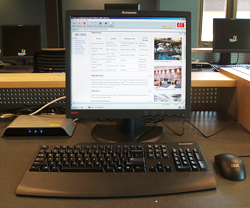by Don Willmott
Last week, an insightful BusinessWeek article got me thinking about the good old days. If you were troubleshooting PCs 20 years ago, you surely recall a burst of excitement over "dumb terminals," a concept left over from the mainframe era that was trying to gain traction. What better solution to solving all of IT's endless PC headaches than to remove all those desktop machines and replace them with small diskless systems that would simply connect to the network, where all the apps and info would reside? Remember Sun's slogan? "The network is the computer."
 As it turned out, the network couldn't handle it. There simply wasn't enough bandwidth and network power to let a busy office worker manipulate a big spreadsheet over the wire. So IT backed off, and the concept of dumb terminals was pretty much shelved in corporate America.
As it turned out, the network couldn't handle it. There simply wasn't enough bandwidth and network power to let a busy office worker manipulate a big spreadsheet over the wire. So IT backed off, and the concept of dumb terminals was pretty much shelved in corporate America.
Well, welcome to 2010. What used to be a dumb terminal is now called a "thin client," and the world seems ready to embrace it. In fact, if you're clutching a smart phone in your hand, you've already got one, at least by some definitions.
Today networks are much faster, servers are infinitely more powerful, and more of us are working remotely. With the power problem solved and the cost advantages obvious (cheaper equipment, less and easier maintenance, improved security), thin-client computing makes good sense.
BusinessWeek describes the scene at iQor, an international outsourcing operation of 11,000 employees where 75 percent of the workers have been transitioned off PCs and onto thin clients from HP. "We refer to thin clients as lollipops," says the company's CEO. "If yours isn't working, just get another one." He hopes to shrink his IT staff by 75 percent. Hmm. Maybe this isn't all good news, after all.
Market surveys suggest that thin clients have already found their happiest homes in public sector deployments such as health care, education, and government. Cash registers can also be considered a kind of thin client, so retail is a big space as well.
IDC says the worldwide thin client market may grow from 2.9 million units in 2007 to 7 million in 2012. Gartner says that by 2014, 15 percent of office-bound desktop PCs will be replaced by what it calls "virtual desktops."
In fact, it's the rapid growth of virtualization that's helping this trend take off. It's now so easy and cheap to virtualize servers and give every worker a nice slice of the network's power that it seems almost silly not to do it. Companies like Citrix Systems, IBM, Red Hat, and VMware are at the vanguard of virtualization.
Microsoft also gets some of the credit, but for all the wrong reasons. Vista was such a bad OS, the thinking goes, that it compelled IT to look for other ways to upgrade. ("Anything but a Vista upgrade.") Windows 7 has changed that landscape, but the mindset is ingrained. What can we do, IT asks, besides buy, set up, install, and troubleshoot 500 desktop PCs and laptops for 500 people at 500 desks? This may be one cost-effective answer.
What's really cool about today's thin clients is they aren't just black boxes that sit on desks. Many, like this brand new one from Wyse, double as netbooks. They're more versatile (and, it should be noted, more expensive).
If you haven't given thin-client concepts much thought in recent years, now is a good time to dive back in. Take a look at the available hardware and at virtualized servers. You'll start to envision some interesting deployments.